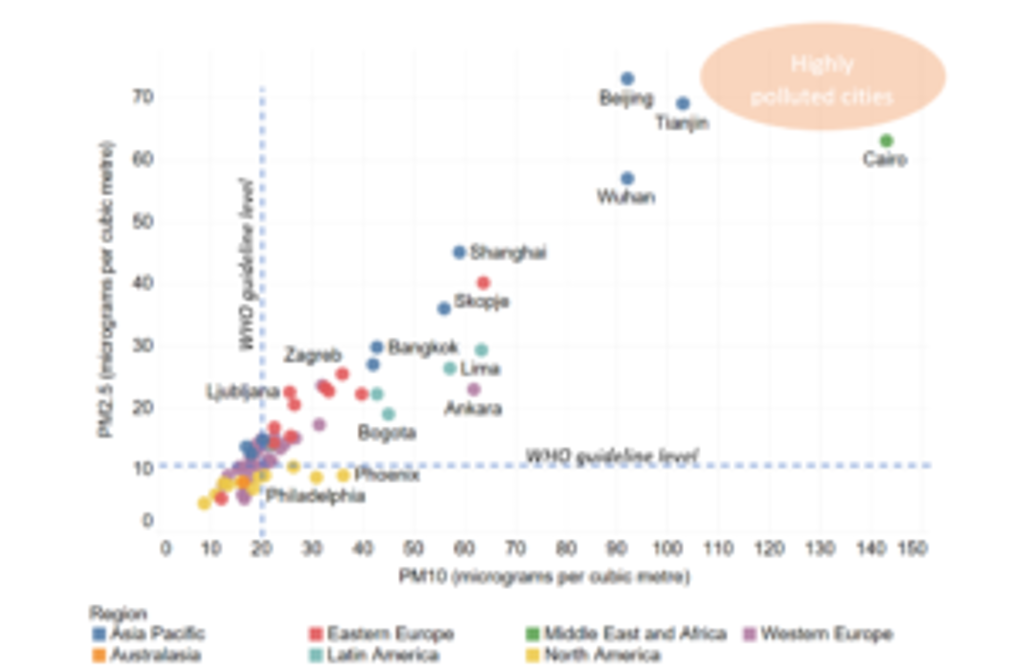Urbanisation and sustainability are central themes in current global trends. Projections by Euromonitor International suggest 60% of the world’s population will be living in cities or urban conurbations by 2030.
Simultaneously, the consequential effects of greenhouse gas emissions are beginning to unfold. Some of the world’s largest cities, including Jakarta, Dhaka and Guangzhou, is at risk from rising sea levels.
Challenging the status quo in urban designs opens new opportunities for housing the surging population and contributing to better ecological sustainability. Purpose-built cities are popping up in large numbers across the world, with the trend being powered by emerging market economies.
PM2.5 and PM10 Mean Annual Levels of Pollution 2016

Water’s importance to sustaining life is paramount
According to UN-endorsed projections, by 2030, global fresh-water demand will exceed supply by 40% due to population growth, disruptive human actions and climate change.
Per capita water consumption grew 11.9% over 2000-2018, making water management measures more critical than ever. Just in the spring of 2018, South Africa’s second-largest city, Cape Town, faced a difficult task of water management after an excessively long period of drought. Other leading global cities, including London, Sao Paulo and Beijing, are predicted to face future water scarcity challenges.
Conservation is a leading topic among urban designers who are responding to the needs of sustainable water management in new and existing cities. The ambitious urban development, Manila Bay - City of Pearl, Philippines, will feature a stormwater collection unit that will have the ability to recycle water, utilising it for irrigation, cooling and flushing in the city’s districts.
Similar features have also been implemented in the newly built South Korean city of Songdo, which has rainwater collection systems that trap water and later reuses it for irrigation and sanitation purposes.
Existing cities are also realising the need to implement more sustainable forms of water management. Boston, for example, requires all large buildings to provide an assessment of water use every five years. Santa Barbara, California introduced infrastructure upgrades and public awareness programmes that have allowed it to decrease water usage by 22% over 2013-2015.
Energy use is a key area of focus to improve sustainability
The pressure to conform to low carbon dependence is intensifying. Renewable fuels such as wind and solar power gaining traction. China, the world’s largest user of energy, saw consumption of solar, wind and other renewables grow ninefold over 2005-2018.
Numerous cities have pledged to reduce their production of greenhouse gas emissions by utilising the latest technologies in green energy. Both Duqm, Oman and Manila Bay - City of Pearl are investing in solar, tidal and wave energy. Even more ambitious plans are being made for Xiong’an New Area, major planned city development in China, which is expected to run on 100% renewable sources.
Across the world, numerous cities, including London, San Francisco and Vancouver, are successfully using green energy to power homes and industry. In the UK, more than 80 towns and cities have made a commitment to using 100% renewable energy by 2050, which further emphasises the commitment local governments are making towards ushering in an era of sustainable cities.
The basic components to building a successful city – access to public amenities, extensive transport infrastructure and provision of numerous cultural offerings, to name a few – remain unchanged. However, sustainable planning principles are progressively becoming vanguards of urbanisation.
Looking ahead, cities will not be limiting themselves to water and energy sustainability. They will be taking steps toward extensive self-sufficiency in food production, waste management and urban mobility. Future cities will not be consigned to acting as engines of pollution and natural resource depletion. Instead, they will be sustainable, equitable and autonomous ecosystems of life, work and leisure. Undeniably, the supply chain and consumer lifestyle disruptions that are set to be borne by these changes will bring large-scale transformations of how we view our future cities and urban consumers.
To learn more, download the report "Brand New Cities: Consumer Markets of the Future".
